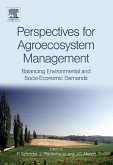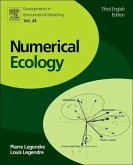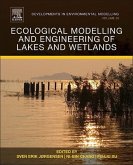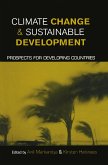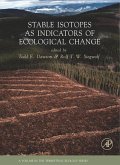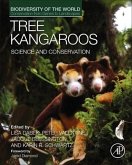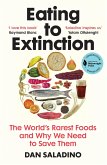- Gebundenes Buch
- Merkliste
- Auf die Merkliste
- Bewerten Bewerten
- Teilen
- Produkt teilen
- Produkterinnerung
- Produkterinnerung
This volume highlights aspects and approaches to questions on the development and findings of biotic indicator (systems), considering the complex problems of conversion into practice. Biotic indication in relation to sustainable land use and biodiversity is discussed from many angles. Covered in this volume are the following topics: * Political requirements and statements on biotic agri-environmental indicators; * Requirements regarding agri-environmental indicators from a scientific as well as an applied point of view; * Scientific reviews and critical discussions of "state of the art"…mehr
Andere Kunden interessierten sich auch für
![Perspectives for Agroecosystem Management: Perspectives for Agroecosystem Management:]() Perspectives for Agroecosystem Management:105,99 €
Perspectives for Agroecosystem Management:105,99 €![Numerical Ecology Numerical Ecology]() Pierre LegendreNumerical Ecology102,50 €
Pierre LegendreNumerical Ecology102,50 €![Ecological Modelling and Engineering of Lakes and Wetlands Ecological Modelling and Engineering of Lakes and Wetlands]() Ecological Modelling and Engineering of Lakes and Wetlands147,99 €
Ecological Modelling and Engineering of Lakes and Wetlands147,99 €![Climate Change and Sustainable Development Climate Change and Sustainable Development]() Anil MarkandyaClimate Change and Sustainable Development202,99 €
Anil MarkandyaClimate Change and Sustainable Development202,99 €![Stable Isotopes as Indicators of Ecological Change Stable Isotopes as Indicators of Ecological Change]() Todd E. Dawson (Volume ed.) / Rolf SiegwolfStable Isotopes as Indicators of Ecological Change123,99 €
Todd E. Dawson (Volume ed.) / Rolf SiegwolfStable Isotopes as Indicators of Ecological Change123,99 €![Tree Kangaroos Tree Kangaroos]() Tree Kangaroos108,99 €
Tree Kangaroos108,99 €![Eating to Extinction Eating to Extinction]() Dan SaladinoEating to Extinction9,99 €
Dan SaladinoEating to Extinction9,99 €-
-
-
This volume highlights aspects and approaches to questions on the development and findings of biotic indicator (systems), considering the complex problems of conversion into practice. Biotic indication in relation to sustainable land use and biodiversity is discussed from many angles. Covered in this volume are the following topics: * Political requirements and statements on biotic agri-environmental indicators; * Requirements regarding agri-environmental indicators from a scientific as well as an applied point of view; * Scientific reviews and critical discussions of "state of the art" knowledge regarding several kinds of agri-environmental indicators for biodiversity and/or sustainable agriculture; * Original experiments on certain aspects regarding indication of biodiversity in agroecosystems; * Practical experience with the application and suitability of agri-environmental indicators (as far as they are already established); * Conceptions and models to show the economic effects and possibilities of practical application of such indicators.
Hinweis: Dieser Artikel kann nur an eine deutsche Lieferadresse ausgeliefert werden.
Hinweis: Dieser Artikel kann nur an eine deutsche Lieferadresse ausgeliefert werden.
Produktdetails
- Produktdetails
- Verlag: Elsevier Science
- Seitenzahl: 560
- Erscheinungstermin: 1. Dezember 2003
- Englisch
- Abmessung: 264mm x 196mm x 38mm
- Gewicht: 1415g
- ISBN-13: 9780444515513
- ISBN-10: 0444515518
- Artikelnr.: 23381802
- Herstellerkennzeichnung
- Libri GmbH
- Europaallee 1
- 36244 Bad Hersfeld
- gpsr@libri.de
- Verlag: Elsevier Science
- Seitenzahl: 560
- Erscheinungstermin: 1. Dezember 2003
- Englisch
- Abmessung: 264mm x 196mm x 38mm
- Gewicht: 1415g
- ISBN-13: 9780444515513
- ISBN-10: 0444515518
- Artikelnr.: 23381802
- Herstellerkennzeichnung
- Libri GmbH
- Europaallee 1
- 36244 Bad Hersfeld
- gpsr@libri.de
Part I. Introduction. Biotic indicators for biodiversity and sustainable
agriculture - introduction and background (W. Büchs). Part II.
Requirements. Environmental policy, agri-environmental indicators and
landscape indicators (H.-P. Piorr). Part III. Biodiversity at different
scale levels. Biodiversity and agri-environmental indicators - general
scopes and skills with special reference to the habitat level (W. Büchs).
Floristic diversity at the habitat scale in agricultural landscapes of
Central Europe - summary, conclusions and perspectives (R. Waldhardt, D.
Simmering, H. Albrecht). Biodiversity indicators: the choice of values and
measures (P. Duelli, M.K. Obrist). Biodiversity, the ultimate
agri-environmental indicator?: Potential and limits for the application of
faunistic elements as gradual indicators in agroecosystems (W. Büchs, A.
Harenberg et al.). Sample size and quality of indication - a case study
using ground-dwelling arthropods as indicators in agricultural ecosystems
(J. Perner). Biotic indicators of carabid species richness on organically
and conventionally managed arable fields (T.F. Döring, A. Hiller et al.).
The spatial and temporal pattern of carabid beetles on arable fields in
northern Germany (Schleswig-Holstein) and their value as ecological
indicators (U. Irmler). Which carabid species benefit from organic
agriculture? - A review of comparative studies in winter cereals from
Germany and Switzerland (T.F. Döring, B. Kromp). Regional diversity of
temporary wetland carabid beetle communities: a matter of landscape
features or cultivation intensity? (U. Brose). Assessment of changing
agricultural land use: response of vegetation, ground-dwelling spiders and
beetles to the conversion of arable land into grassland (J. Perner, S.
Malt). Auchenorrhyncha communities as indicators of disturbance in
grasslands (Insecta, Hemiptera) - a case study from the Elbe flood plains
(northern Germany) (H. Nickel, J. Hildebrandt). Suitability of arable weeds
as indicator organisms to evaluate species conservation effects of
management in agricultural ecosystems (H. Albrecht). Morphometric
parameters: an approach for the indication of environmental conditions on
calcareous grassland (C. Mückschel, A. Otte). Selecting target species to
evaluate the success of wet grassland restoration (G. Rosenthal).
Development and control of weeds in arable farming systems (B. Gerowitt).
Indicators for evaluating soil quality (M. Schloter, O. Dilly, J.C. Munch).
A biological classification concept for the assessment of soil quality:
"biological soil classification scheme" (BBSK) (A. Ruf, L. Beck et al.). On
the quality of soil biodiversity indicators: abiotic and biotic parameters
as predictors of soil faunal richness at different spatial scales (K.
Ekschmitt, T. Stierhof et al.). Microbial eco-physiological indicators to
asses soil quality (T.-H. Anderson). Influence of precision farming on the
microbial community structure and functions in nitrogen turnover (M.
Schloter, H.-J. Bach et al.). Biodiversity and landscape - summary,
conclusions and perspectives (R. Waldhardt). Quantifying the impact of
landscape and habitat features on biodiversity in cultivated landscapes
(Ph. Jeanneret, B. Schüpbach, H. Luka). Landscape structure as an indicator
of biodiversity: matrix effects on species richness (J. Dauber, M. Hirsch
et al.). The influence of matrix type on flower visitors of Centaurea jacea
L. (M. Hirsch, S. Pfaff, V. Wolters). Indicators of plant species and
community diversity in grasslands (R. Waldhardt, A. Otte). Effects of
landscape patterns on species richness - a modelling approach (N.C.
Steiner, W. Köhler).
Landscape indicators from ecological area sampling in Germany (R.
Hoffmann-Kroll, D. Schäfer, S. Seibel). Operationalisation of a
landscape-oriented indicator (E. Osinski). Mosaic indicators - theoretical
approach for the development of indicators for species diversity in
agricultural landscapes (J. Hoffmann, J.M. Greef). Practical example of the
mosaic indicators approach (J. Hoffmann, J.M. Greef et al.). Part IV.
Experiences and applications. Application of biotic indicators for
evaluation of sustainable land use - current procedures and future
developments (E. Osinski, U. Meier et al.). Bio-resource evaluation within
agri-environmental assessment tools in different European countries (D.
Braband, U. Geier, U. Köpke). Method for assessing the proportion of
ecologically, culturally and provincially significant areas (OELF) in
agrarian spaces used as a criterion for environmental friendly agriculture
(D. Roth, M. Schwabe). Experiences with the application, recordation and
valuation of agri-environmental indicators in agricultural practice (M.
Menge). Field related organisms as possible indicators for evaluation of
land use intensity (W. Heyer, K.-J. Hülsbergen et al.). Nature balance
scheme for farms - evaluation of the ecological situation (R. Oppermann).
Part V. Economy. Economic perspectives of using indicators (E. Osinski, J.
Kantelhardt, A. Heissenhuber). Money as an indicator: to make use of
economic evaluation for biodiversity conservation (I. Bräuer). Threshold
values for nature protection areas as indicators for bio-diversity - a
regional evaluation of economic and ecological consequences (S. Herrmann,
S. Dabbert, H.-G. Schwarz-von Raumer). Comparative assessment of
agri-environment programmes in federal states of Germany (R. Marggraf). Is
there a reliable correlation between hedgerow density and agricultural site
conditions? (J. Kantelhardt, E. Osinski, A. Heissenhuber). Consideration of
biotic nature conservation targets in agricultural land use - a case study
from the Biosphere Reserve Schorfheide-Chorin (A. Meyer-Aurich, P. Zander,
M. Hermann). Rewards for ecological goods - requirements and perspectives
for agricultural land use (B. Gerowitt, J. Isselstein, R. Marggraf). Author
Index. Subject Index. Volume Contents. Editorial Advisory Board.
agriculture - introduction and background (W. Büchs). Part II.
Requirements. Environmental policy, agri-environmental indicators and
landscape indicators (H.-P. Piorr). Part III. Biodiversity at different
scale levels. Biodiversity and agri-environmental indicators - general
scopes and skills with special reference to the habitat level (W. Büchs).
Floristic diversity at the habitat scale in agricultural landscapes of
Central Europe - summary, conclusions and perspectives (R. Waldhardt, D.
Simmering, H. Albrecht). Biodiversity indicators: the choice of values and
measures (P. Duelli, M.K. Obrist). Biodiversity, the ultimate
agri-environmental indicator?: Potential and limits for the application of
faunistic elements as gradual indicators in agroecosystems (W. Büchs, A.
Harenberg et al.). Sample size and quality of indication - a case study
using ground-dwelling arthropods as indicators in agricultural ecosystems
(J. Perner). Biotic indicators of carabid species richness on organically
and conventionally managed arable fields (T.F. Döring, A. Hiller et al.).
The spatial and temporal pattern of carabid beetles on arable fields in
northern Germany (Schleswig-Holstein) and their value as ecological
indicators (U. Irmler). Which carabid species benefit from organic
agriculture? - A review of comparative studies in winter cereals from
Germany and Switzerland (T.F. Döring, B. Kromp). Regional diversity of
temporary wetland carabid beetle communities: a matter of landscape
features or cultivation intensity? (U. Brose). Assessment of changing
agricultural land use: response of vegetation, ground-dwelling spiders and
beetles to the conversion of arable land into grassland (J. Perner, S.
Malt). Auchenorrhyncha communities as indicators of disturbance in
grasslands (Insecta, Hemiptera) - a case study from the Elbe flood plains
(northern Germany) (H. Nickel, J. Hildebrandt). Suitability of arable weeds
as indicator organisms to evaluate species conservation effects of
management in agricultural ecosystems (H. Albrecht). Morphometric
parameters: an approach for the indication of environmental conditions on
calcareous grassland (C. Mückschel, A. Otte). Selecting target species to
evaluate the success of wet grassland restoration (G. Rosenthal).
Development and control of weeds in arable farming systems (B. Gerowitt).
Indicators for evaluating soil quality (M. Schloter, O. Dilly, J.C. Munch).
A biological classification concept for the assessment of soil quality:
"biological soil classification scheme" (BBSK) (A. Ruf, L. Beck et al.). On
the quality of soil biodiversity indicators: abiotic and biotic parameters
as predictors of soil faunal richness at different spatial scales (K.
Ekschmitt, T. Stierhof et al.). Microbial eco-physiological indicators to
asses soil quality (T.-H. Anderson). Influence of precision farming on the
microbial community structure and functions in nitrogen turnover (M.
Schloter, H.-J. Bach et al.). Biodiversity and landscape - summary,
conclusions and perspectives (R. Waldhardt). Quantifying the impact of
landscape and habitat features on biodiversity in cultivated landscapes
(Ph. Jeanneret, B. Schüpbach, H. Luka). Landscape structure as an indicator
of biodiversity: matrix effects on species richness (J. Dauber, M. Hirsch
et al.). The influence of matrix type on flower visitors of Centaurea jacea
L. (M. Hirsch, S. Pfaff, V. Wolters). Indicators of plant species and
community diversity in grasslands (R. Waldhardt, A. Otte). Effects of
landscape patterns on species richness - a modelling approach (N.C.
Steiner, W. Köhler).
Landscape indicators from ecological area sampling in Germany (R.
Hoffmann-Kroll, D. Schäfer, S. Seibel). Operationalisation of a
landscape-oriented indicator (E. Osinski). Mosaic indicators - theoretical
approach for the development of indicators for species diversity in
agricultural landscapes (J. Hoffmann, J.M. Greef). Practical example of the
mosaic indicators approach (J. Hoffmann, J.M. Greef et al.). Part IV.
Experiences and applications. Application of biotic indicators for
evaluation of sustainable land use - current procedures and future
developments (E. Osinski, U. Meier et al.). Bio-resource evaluation within
agri-environmental assessment tools in different European countries (D.
Braband, U. Geier, U. Köpke). Method for assessing the proportion of
ecologically, culturally and provincially significant areas (OELF) in
agrarian spaces used as a criterion for environmental friendly agriculture
(D. Roth, M. Schwabe). Experiences with the application, recordation and
valuation of agri-environmental indicators in agricultural practice (M.
Menge). Field related organisms as possible indicators for evaluation of
land use intensity (W. Heyer, K.-J. Hülsbergen et al.). Nature balance
scheme for farms - evaluation of the ecological situation (R. Oppermann).
Part V. Economy. Economic perspectives of using indicators (E. Osinski, J.
Kantelhardt, A. Heissenhuber). Money as an indicator: to make use of
economic evaluation for biodiversity conservation (I. Bräuer). Threshold
values for nature protection areas as indicators for bio-diversity - a
regional evaluation of economic and ecological consequences (S. Herrmann,
S. Dabbert, H.-G. Schwarz-von Raumer). Comparative assessment of
agri-environment programmes in federal states of Germany (R. Marggraf). Is
there a reliable correlation between hedgerow density and agricultural site
conditions? (J. Kantelhardt, E. Osinski, A. Heissenhuber). Consideration of
biotic nature conservation targets in agricultural land use - a case study
from the Biosphere Reserve Schorfheide-Chorin (A. Meyer-Aurich, P. Zander,
M. Hermann). Rewards for ecological goods - requirements and perspectives
for agricultural land use (B. Gerowitt, J. Isselstein, R. Marggraf). Author
Index. Subject Index. Volume Contents. Editorial Advisory Board.
Part I. Introduction. Biotic indicators for biodiversity and sustainable
agriculture - introduction and background (W. Büchs). Part II.
Requirements. Environmental policy, agri-environmental indicators and
landscape indicators (H.-P. Piorr). Part III. Biodiversity at different
scale levels. Biodiversity and agri-environmental indicators - general
scopes and skills with special reference to the habitat level (W. Büchs).
Floristic diversity at the habitat scale in agricultural landscapes of
Central Europe - summary, conclusions and perspectives (R. Waldhardt, D.
Simmering, H. Albrecht). Biodiversity indicators: the choice of values and
measures (P. Duelli, M.K. Obrist). Biodiversity, the ultimate
agri-environmental indicator?: Potential and limits for the application of
faunistic elements as gradual indicators in agroecosystems (W. Büchs, A.
Harenberg et al.). Sample size and quality of indication - a case study
using ground-dwelling arthropods as indicators in agricultural ecosystems
(J. Perner). Biotic indicators of carabid species richness on organically
and conventionally managed arable fields (T.F. Döring, A. Hiller et al.).
The spatial and temporal pattern of carabid beetles on arable fields in
northern Germany (Schleswig-Holstein) and their value as ecological
indicators (U. Irmler). Which carabid species benefit from organic
agriculture? - A review of comparative studies in winter cereals from
Germany and Switzerland (T.F. Döring, B. Kromp). Regional diversity of
temporary wetland carabid beetle communities: a matter of landscape
features or cultivation intensity? (U. Brose). Assessment of changing
agricultural land use: response of vegetation, ground-dwelling spiders and
beetles to the conversion of arable land into grassland (J. Perner, S.
Malt). Auchenorrhyncha communities as indicators of disturbance in
grasslands (Insecta, Hemiptera) - a case study from the Elbe flood plains
(northern Germany) (H. Nickel, J. Hildebrandt). Suitability of arable weeds
as indicator organisms to evaluate species conservation effects of
management in agricultural ecosystems (H. Albrecht). Morphometric
parameters: an approach for the indication of environmental conditions on
calcareous grassland (C. Mückschel, A. Otte). Selecting target species to
evaluate the success of wet grassland restoration (G. Rosenthal).
Development and control of weeds in arable farming systems (B. Gerowitt).
Indicators for evaluating soil quality (M. Schloter, O. Dilly, J.C. Munch).
A biological classification concept for the assessment of soil quality:
"biological soil classification scheme" (BBSK) (A. Ruf, L. Beck et al.). On
the quality of soil biodiversity indicators: abiotic and biotic parameters
as predictors of soil faunal richness at different spatial scales (K.
Ekschmitt, T. Stierhof et al.). Microbial eco-physiological indicators to
asses soil quality (T.-H. Anderson). Influence of precision farming on the
microbial community structure and functions in nitrogen turnover (M.
Schloter, H.-J. Bach et al.). Biodiversity and landscape - summary,
conclusions and perspectives (R. Waldhardt). Quantifying the impact of
landscape and habitat features on biodiversity in cultivated landscapes
(Ph. Jeanneret, B. Schüpbach, H. Luka). Landscape structure as an indicator
of biodiversity: matrix effects on species richness (J. Dauber, M. Hirsch
et al.). The influence of matrix type on flower visitors of Centaurea jacea
L. (M. Hirsch, S. Pfaff, V. Wolters). Indicators of plant species and
community diversity in grasslands (R. Waldhardt, A. Otte). Effects of
landscape patterns on species richness - a modelling approach (N.C.
Steiner, W. Köhler).
Landscape indicators from ecological area sampling in Germany (R.
Hoffmann-Kroll, D. Schäfer, S. Seibel). Operationalisation of a
landscape-oriented indicator (E. Osinski). Mosaic indicators - theoretical
approach for the development of indicators for species diversity in
agricultural landscapes (J. Hoffmann, J.M. Greef). Practical example of the
mosaic indicators approach (J. Hoffmann, J.M. Greef et al.). Part IV.
Experiences and applications. Application of biotic indicators for
evaluation of sustainable land use - current procedures and future
developments (E. Osinski, U. Meier et al.). Bio-resource evaluation within
agri-environmental assessment tools in different European countries (D.
Braband, U. Geier, U. Köpke). Method for assessing the proportion of
ecologically, culturally and provincially significant areas (OELF) in
agrarian spaces used as a criterion for environmental friendly agriculture
(D. Roth, M. Schwabe). Experiences with the application, recordation and
valuation of agri-environmental indicators in agricultural practice (M.
Menge). Field related organisms as possible indicators for evaluation of
land use intensity (W. Heyer, K.-J. Hülsbergen et al.). Nature balance
scheme for farms - evaluation of the ecological situation (R. Oppermann).
Part V. Economy. Economic perspectives of using indicators (E. Osinski, J.
Kantelhardt, A. Heissenhuber). Money as an indicator: to make use of
economic evaluation for biodiversity conservation (I. Bräuer). Threshold
values for nature protection areas as indicators for bio-diversity - a
regional evaluation of economic and ecological consequences (S. Herrmann,
S. Dabbert, H.-G. Schwarz-von Raumer). Comparative assessment of
agri-environment programmes in federal states of Germany (R. Marggraf). Is
there a reliable correlation between hedgerow density and agricultural site
conditions? (J. Kantelhardt, E. Osinski, A. Heissenhuber). Consideration of
biotic nature conservation targets in agricultural land use - a case study
from the Biosphere Reserve Schorfheide-Chorin (A. Meyer-Aurich, P. Zander,
M. Hermann). Rewards for ecological goods - requirements and perspectives
for agricultural land use (B. Gerowitt, J. Isselstein, R. Marggraf). Author
Index. Subject Index. Volume Contents. Editorial Advisory Board.
agriculture - introduction and background (W. Büchs). Part II.
Requirements. Environmental policy, agri-environmental indicators and
landscape indicators (H.-P. Piorr). Part III. Biodiversity at different
scale levels. Biodiversity and agri-environmental indicators - general
scopes and skills with special reference to the habitat level (W. Büchs).
Floristic diversity at the habitat scale in agricultural landscapes of
Central Europe - summary, conclusions and perspectives (R. Waldhardt, D.
Simmering, H. Albrecht). Biodiversity indicators: the choice of values and
measures (P. Duelli, M.K. Obrist). Biodiversity, the ultimate
agri-environmental indicator?: Potential and limits for the application of
faunistic elements as gradual indicators in agroecosystems (W. Büchs, A.
Harenberg et al.). Sample size and quality of indication - a case study
using ground-dwelling arthropods as indicators in agricultural ecosystems
(J. Perner). Biotic indicators of carabid species richness on organically
and conventionally managed arable fields (T.F. Döring, A. Hiller et al.).
The spatial and temporal pattern of carabid beetles on arable fields in
northern Germany (Schleswig-Holstein) and their value as ecological
indicators (U. Irmler). Which carabid species benefit from organic
agriculture? - A review of comparative studies in winter cereals from
Germany and Switzerland (T.F. Döring, B. Kromp). Regional diversity of
temporary wetland carabid beetle communities: a matter of landscape
features or cultivation intensity? (U. Brose). Assessment of changing
agricultural land use: response of vegetation, ground-dwelling spiders and
beetles to the conversion of arable land into grassland (J. Perner, S.
Malt). Auchenorrhyncha communities as indicators of disturbance in
grasslands (Insecta, Hemiptera) - a case study from the Elbe flood plains
(northern Germany) (H. Nickel, J. Hildebrandt). Suitability of arable weeds
as indicator organisms to evaluate species conservation effects of
management in agricultural ecosystems (H. Albrecht). Morphometric
parameters: an approach for the indication of environmental conditions on
calcareous grassland (C. Mückschel, A. Otte). Selecting target species to
evaluate the success of wet grassland restoration (G. Rosenthal).
Development and control of weeds in arable farming systems (B. Gerowitt).
Indicators for evaluating soil quality (M. Schloter, O. Dilly, J.C. Munch).
A biological classification concept for the assessment of soil quality:
"biological soil classification scheme" (BBSK) (A. Ruf, L. Beck et al.). On
the quality of soil biodiversity indicators: abiotic and biotic parameters
as predictors of soil faunal richness at different spatial scales (K.
Ekschmitt, T. Stierhof et al.). Microbial eco-physiological indicators to
asses soil quality (T.-H. Anderson). Influence of precision farming on the
microbial community structure and functions in nitrogen turnover (M.
Schloter, H.-J. Bach et al.). Biodiversity and landscape - summary,
conclusions and perspectives (R. Waldhardt). Quantifying the impact of
landscape and habitat features on biodiversity in cultivated landscapes
(Ph. Jeanneret, B. Schüpbach, H. Luka). Landscape structure as an indicator
of biodiversity: matrix effects on species richness (J. Dauber, M. Hirsch
et al.). The influence of matrix type on flower visitors of Centaurea jacea
L. (M. Hirsch, S. Pfaff, V. Wolters). Indicators of plant species and
community diversity in grasslands (R. Waldhardt, A. Otte). Effects of
landscape patterns on species richness - a modelling approach (N.C.
Steiner, W. Köhler).
Landscape indicators from ecological area sampling in Germany (R.
Hoffmann-Kroll, D. Schäfer, S. Seibel). Operationalisation of a
landscape-oriented indicator (E. Osinski). Mosaic indicators - theoretical
approach for the development of indicators for species diversity in
agricultural landscapes (J. Hoffmann, J.M. Greef). Practical example of the
mosaic indicators approach (J. Hoffmann, J.M. Greef et al.). Part IV.
Experiences and applications. Application of biotic indicators for
evaluation of sustainable land use - current procedures and future
developments (E. Osinski, U. Meier et al.). Bio-resource evaluation within
agri-environmental assessment tools in different European countries (D.
Braband, U. Geier, U. Köpke). Method for assessing the proportion of
ecologically, culturally and provincially significant areas (OELF) in
agrarian spaces used as a criterion for environmental friendly agriculture
(D. Roth, M. Schwabe). Experiences with the application, recordation and
valuation of agri-environmental indicators in agricultural practice (M.
Menge). Field related organisms as possible indicators for evaluation of
land use intensity (W. Heyer, K.-J. Hülsbergen et al.). Nature balance
scheme for farms - evaluation of the ecological situation (R. Oppermann).
Part V. Economy. Economic perspectives of using indicators (E. Osinski, J.
Kantelhardt, A. Heissenhuber). Money as an indicator: to make use of
economic evaluation for biodiversity conservation (I. Bräuer). Threshold
values for nature protection areas as indicators for bio-diversity - a
regional evaluation of economic and ecological consequences (S. Herrmann,
S. Dabbert, H.-G. Schwarz-von Raumer). Comparative assessment of
agri-environment programmes in federal states of Germany (R. Marggraf). Is
there a reliable correlation between hedgerow density and agricultural site
conditions? (J. Kantelhardt, E. Osinski, A. Heissenhuber). Consideration of
biotic nature conservation targets in agricultural land use - a case study
from the Biosphere Reserve Schorfheide-Chorin (A. Meyer-Aurich, P. Zander,
M. Hermann). Rewards for ecological goods - requirements and perspectives
for agricultural land use (B. Gerowitt, J. Isselstein, R. Marggraf). Author
Index. Subject Index. Volume Contents. Editorial Advisory Board.


